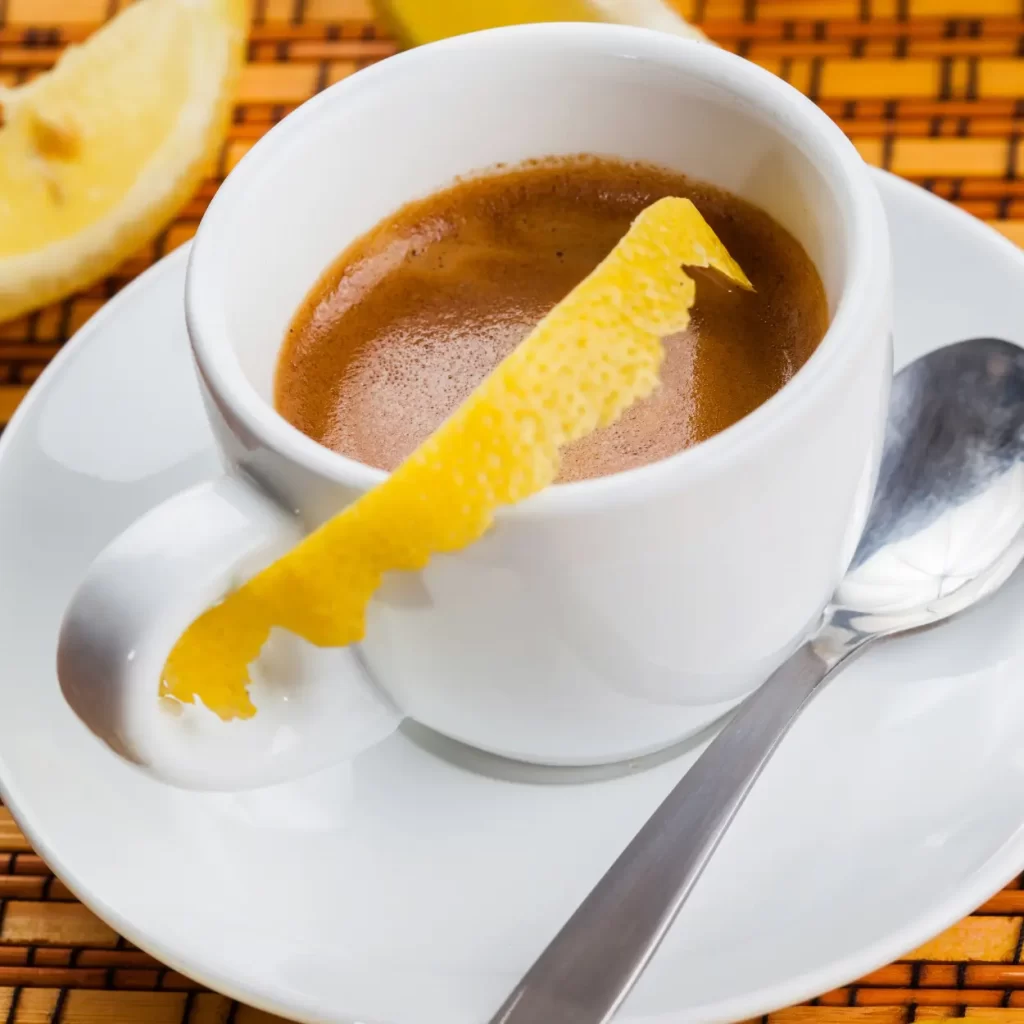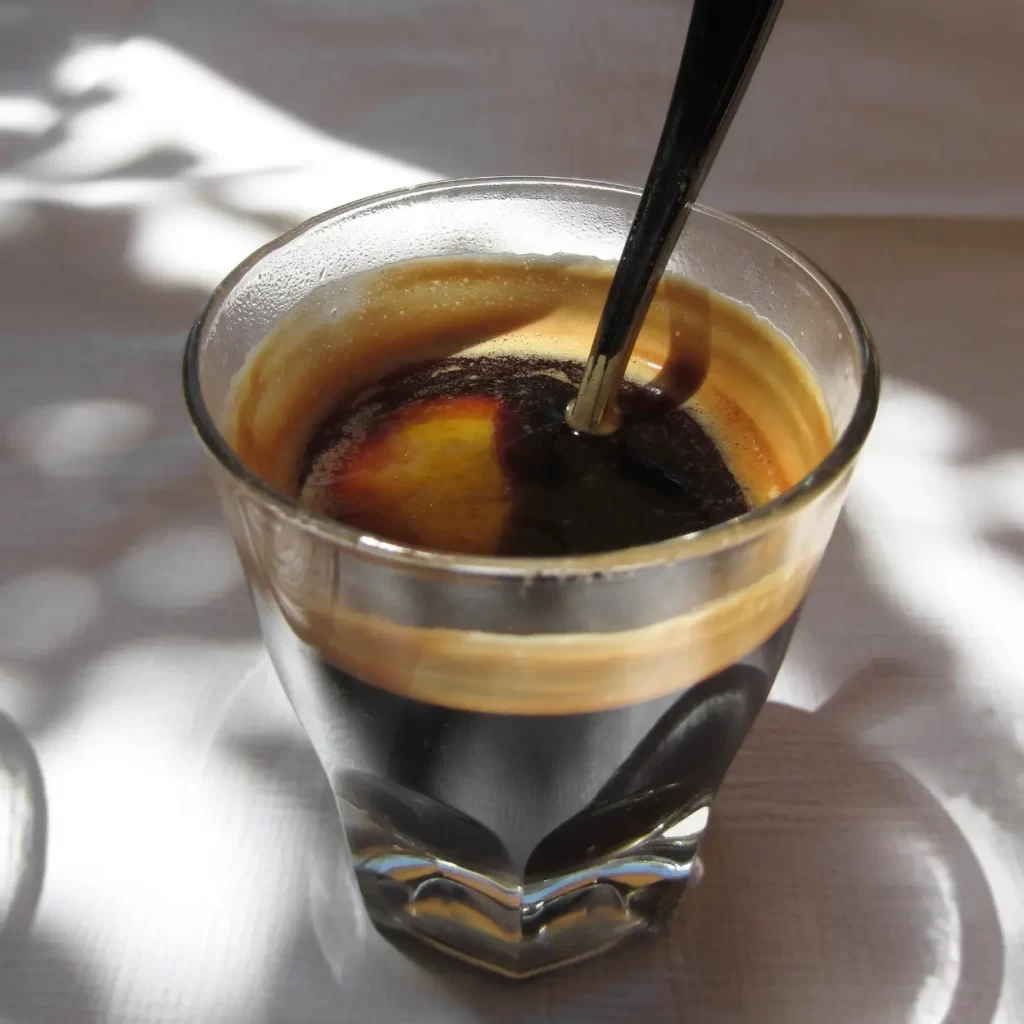Welcome to an in-depth journey into the world of Espresso Romano, a drink that has captivated coffee lovers and influenced global coffee culture in surprising ways. This article delves into the intriguing, albeit mysterious, origins of this beverage, whether born in the coffee-loving nation of Italy or elsewhere. We’ll explore its unique flavor profile, a harmonious blend of acidic citrus and coffee bitterness, as scrutinized by experts and coffee enthusiasts alike. As we move beyond the cup, we’ll also look at how this drink has become a cultural staple, influencing modern coffee trends and even inspiring creative espresso romano recipes. So, prepare for an intimate dive into this citrusy sip that represents much more than just a caffeinated kick—it’s a complex concoction that bridges history, culture, and culinary artistry.
Espresso Romano: Key Takeaway
- Origin Mysteries: This drink’s origins, while having a distinct connection to Italy, remain intriguingly elusive, with stories suggesting its birthplace could range from Italy to France or even be an American invention with Italian branding.
- Unique Flavor Profile: The espresso drink stands out for its harmonious blend of acidic citrus and the inherent bitterness of coffee, a balance highlighted by experts such as Dr. Wilton Soares Cardoso.
- Cultural Significance: Beyond its taste, this beverage holds a special place in coffee culture. In Italy, it represents an intriguing deviation from traditional coffee drinking habits, and globally, it is viewed as both a novel and beneficial drink choice.
- Influence on Modern Coffee Trends: This concoction’s citrusy essence has sparked flavor innovations in the coffee industry, paving the way for other fruit-infused espresso beverages and inspiring mixologists to experiment further.
- Do-It-Yourself Possibility: For those looking to recreate this unique beverage, the espresso romano recipe offers a simple yet refreshing way to elevate the usual coffee experience, merging historical flavors with contemporary tastes.
What is Espresso Romano?

Espresso Romano is a distinctive Italian coffee drink that marries a shot of espresso with the zesty flair of lemon. Often known as “caffè Romano,” this libation offers the choice of a single or double espresso shot, accompanied by a lemon slice. Generally, the lemon is grazed along the edge of the cup prior to being infused into the coffee, adding a citrusy nuance. This concoction may also include a dash of sugar and the option of using candied lemon. Versatile by nature, this delightful coffee drink can be savored hot, cold, or even iced, and accommodates those who prefer it with or without milk. Explore further to discover this beverage’s benefits that make it a unique choice among coffee aficionados.
The Origin and History
Understanding the inception and transformation of this delectable concoction is like piecing together an intricate puzzle. Its origins are enigmatic, with cultural, historical, and culinary influences that add layers of complexity. Let’s dive deeper into this rich tapestry, tracing it from its alleged Roman connections to its evolution and representation in pop culture.
The Roman Connection

The name “Espresso Romano” would make you think that this intriguing coffee variation hails directly from Rome, Italy. However, this is a murky area in the beverage’s history:
- Deceptive Naming: Some argue that the drink is not Italian at all but is an American invention given an “Italian-sounding” name to lure tourists and create an aura of authenticity.
- French Possibility: Others posit that the origin could actually be French, lending an international flair to the drink’s background.
- Italian Anecdotes: Although there’s no concrete evidence confirming its Italian birth, some stories suggest that the beverage might have been invented there, likely as an adaptation to poor-quality coffee available during economic crises.
In sum, the Roman connection may be more of a romanticized notion than a historical fact, and the debate about its origin remains an open question.
Evolution of Espresso Varieties

Over the years, espresso has seen numerous iterations and modifications:
- Classic Espresso: Originally, espresso was a simple, quick way to enjoy coffee, often consumed as a shot.
- Latte, Cappuccino, and More: With time, more varieties like lattes, cappuccinos, and Americanos have emerged, each offering a different blend of milk, foam, and water.
- Gourmet Versions: In recent years, we’ve seen an influx of gourmet twists, such as spiced espressos and those infused with alternative milks.
This beverage stands out among these for its unique pairing of coffee and citrus, an untraditional yet fascinating blend that adds a layer of complexity to the espresso experience.
Espresso Romano in Pop Culture
This delicacy has carved a unique niche in popular culture:
- Movies and TV Shows: While it may not be as famous as some other drinks, it has been featured in several movies and TV episodes, often as a sophisticated or exotic choice for characters.
- Social Media Trends: It has also made its rounds on social media platforms like Instagram and TikTok, where coffee aficionados and baristas showcase their versions of the perfect Espresso Romano.
- Literature: Occasionally, the beverage also finds its way into novels and travel memoirs, particularly those set in Italian locales or focused on culinary journeys.
As this delectable coffee drink gains more recognition, its role in pop culture is likely to grow, further solidifying its status as a unique and versatile coffee option.
How to Make Espresso Romano: The Unique Preparation

The preparation of this concoction is an art form that balances the robust nature of espresso with the tangy zest of lemon. It may seem like a straightforward task, but achieving the perfect harmony between these contrasting flavors requires a meticulous approach. From selecting the ideal espresso beans to mastering the espresso pull and appreciating the multifaceted role of lemon, this guide will take you through how to make this drink with finesse.
Choosing the Right Espresso Beans

Picking the perfect espresso bean is the cornerstone of any good espresso romano recipe:
- Origin: Coffee beans from South America are often noted for their balanced flavor profile—neither too acidic nor too bitter—which makes them a good match for the lemon’s citrus notes.
- Roast: A medium to dark roast is generally recommended for this coffee, as it provides a robust, full-bodied flavor that can stand up to the addition of lemon.
- Freshness: It’s essential to use freshly roasted and freshly ground beans to ensure that the espresso’s nuanced flavors are fully captured.
Choosing the right beans sets the stage for a truly exceptional experience.
The Perfect Pull: Techniques for the Best Shot
Executing the perfect pull is an essential step in the preparation of this concoction:
- Grind Size: Aim for a fine grind, but not too fine that it clogs your espresso machine. The ideal grind should have the consistency of table salt.
- Temperature: Ensure the machine’s water temperature is between 195°F to 205°F for optimal extraction.
- Pressure: Most espresso machines should operate at a pressure of 9 to 15 bars. Consistency is key, so if you’re pulling manually, try to apply even pressure throughout.
The intricacy lies in mastering these variables to pull a shot that stands up well to the addition of lemon, making this concoction truly sublime.
The Role of Lemon: More Than Just a Garnish

The lemon in coffee serves a multi-dimensional role:
- Flavor Enhancement: The citrusy zing of the lemon works to highlight the natural notes in the espresso, making for a more complex flavor profile.
- Historical Context: In times past, the lemon was likely used to mask the undesirable flavors of low-quality coffee. Today, it adds an exotic twist to the conventional espresso.
- Preparation Nuance: Rubbing the lemon slice along the rim of the cup before squeezing it into the coffee infuses the beverage with subtle lemon undertones, enhancing the drink without overwhelming it.
Far from being just a decorative touch, the lemon is integral to the unique character of this coffee drink, adding depth and complexity to the traditional espresso shot.
Tasting Notes and Flavor Profile

The experience of sipping an Espresso Romano is a nuanced journey through a unique landscape of flavors and aromas. Its profile is an extraordinary fusion of the deep, rich bitterness of espresso and the fresh, tangy zest of lemon. Understanding this intricate blend can elevate your coffee experience to new levels, providing insights for perfect pairings and debunking some common myths surrounding its taste.
The Harmony of Bitter and Citrus
This refreshing concoction captures the essence of two distinct but harmonious flavors:
- Bitter Foundation: The espresso forms the backbone of the drink, with its complex layers of bitter and roasted notes that can range from dark chocolate to toasted almonds depending on the bean.
- Citrus Highlight: The addition of lemon acts like a spotlight, accentuating some of the more subtle undertones of the espresso while introducing a fresh, citrusy contrast that prevents the bitterness from overwhelming the palate.
This union creates a delightful complexity, transforming what might otherwise be a simple espresso shot into an intricately balanced beverage.
Pairing Suggestions for Espresso Romano

Opting for the right companions to your cup of this beverage can add an extra layer to your coffee enjoyment. Here are some coffee pairing ideas:
- Savory Options: Because of its complexity, this drink pairs well with mild, savory foods like cheese or a lightly seasoned chicken sandwich.
- Sweet Choices: If you’re in the mood for something sweeter, consider pairing it with almond biscotti or a slice of lemon pound cake to echo the citrus notes.
- Simple Snacks: Sometimes the best pairing is a simple one. A classic croissant or a plain scone can be an excellent canvas to allow this concoction to shine.
Choosing the right pairing not only enhances this delicacy but also turns the act of drinking it into a full culinary event.
Common Misconceptions about Its Taste
When it comes to this drink, there are several misunderstandings regarding its flavor profile:
- Too Bitter: Many assume that the combination of espresso and lemon would create an overwhelmingly bitter drink, but the lemon actually balances the bitterness of the coffee.
- Overpowered by Citrus: Others think the lemon will dominate the espresso. In reality, if prepared correctly, the lemon serves to accentuate rather than mask the espresso’s nuances.
- Not for Everyone: Some may presume that this is a specialty drink suited only for the adventurous. While it does have a unique taste, many find it to be an unexpectedly pleasant experience.
In the end, the best way to understand this beverage is to experience it for yourself, allowing you to appreciate its intricate flavors and perhaps even debunk some myths along the way.
Comparing with Other Espresso Drinks

This concoction is but one gem in a treasure trove of espresso-based beverages, each with its own unique set of characteristics and flavors. While it may seem like just another espresso variant, the nuances that set it apart become more evident when compared to other popular choices like Espresso Con Panna and Ristretto. Additionally, espresso drinks have been adopted and adapted globally, manifesting in a diverse range of regional variations.
Espresso Romano Vs. Espresso Con Panna

The divergence between these two espresso offerings lies primarily in their accompanying elements:
- Taste: Caffè Romano introduces a citrusy note through its lemon slice, while Espresso Con Panna counters the bitterness of espresso with the sweetness and texture of whipped cream. (1)
- Texture: Espresso Con Panna delivers a creamy, rich mouthfeel due to the whipped cream, contrasting with Romano’s leaner and more vibrant texture.
- Occasion: Espresso Con Panna is often seen as a more indulgent option, perfect for dessert or as a treat, whereas Espresso Romano is considered more versatile, and suitable for any time of the day.
Though both drinks start with a base of espresso, their unique additions lead to completely different tasting experiences.
The Citrusy Difference: Romano Vs. Ristretto

While both drinks center around espresso, they offer distinct experiences:
- Concentration: Ristretto is essentially a more concentrated form of espresso, with less water and the same amount of coffee, yielding an intensely robust shot. (2)
- Flavor Balance: The concentrated nature of Ristretto brings forward darker, richer flavors, whereas the lemon in caffè romano lends a lighter, more balanced profile.
- Flexibility: Espresso Romano offers a flavor that pairs well with both sweet and savory, while Ristretto is generally savored on its own due to its intensity.
The choice between the two often boils down to whether you prefer a more intense coffee experience or one balanced by citrusy notes.
Global Variations of Espresso Drinks

The espresso has become a global phenomenon, inspiring a wide range of interpretations:
- Americano: Originating in the United States, this is espresso diluted with hot water, creating a less intense but still flavorful beverage.
- Flat White: A New Zealand and Australian favorite, it combines espresso with steamed milk, offering a smoother, creamier espresso experience.
- Café Cubano: A staple in Cuban coffee culture, this is an espresso shot sweetened with natural brown sugar, creating a sweeter, thicker variant.
Each region lends its unique touch to espresso, expanding the family of beverages that stem from this classic Italian creation.
By understanding how this concoction stacks up against other espresso drinks, we can better appreciate its unique place in the world of coffee.
The Cultural Impact and Popularity
The allure of this beverage extends beyond its unique flavor profile. This espresso variant has not only captivated coffee enthusiasts but also has had a noteworthy influence on broader coffee culture, from Italy to the international stage and even shaping contemporary coffee trends.
The Coffee Culture in Italy
In Italy, where coffee is more than just a drink—it’s a lifestyle—this drink stands as an intriguing deviation from the standard espresso shot. Traditionally, Italians have a rich coffee culture that often favors pure espresso, devoid of additives:
- Simplicity: In Italy, espresso is commonly consumed in its pure form, typically without sugar, milk, or other additives.
- Acceptance: Despite the general preference for unadulterated espresso, this concoction has found its niche, capturing the hearts of those who appreciate its balanced harmony of bitter and acidic flavors.
By becoming a part of Italy’s complex coffee tapestry, this coffee drink adds an exciting twist to a time-honored tradition.
How the World Perceives Espresso Romano
Globally, this delicacy is increasingly recognized not just as an exotic variety but also as a coffee option that blends taste with potential benefits. Drawing on insights from Dr. Wilton Soares Cardoso, researcher, teacher, and doctor at Brazil’s Instituto Federal de Educação, Ciência e Tecnologia, the citric acid and bitterness in this drink work together to create a balanced and enjoyable beverage. This has piqued the interest of coffee connoisseurs around the world:
- Versatility: It’s an adaptable drink that appeals to both traditionalists and experimenters, enjoyed hot or cold.
- Wellness Angle: The blend of bitterness and acidity is seen not only as a flavorful experience but also as a unique approach to making coffee more drinkable and possibly even beneficial.
This tasty coffee drink is carving out a global reputation as a versatile and thoughtful coffee option.
Espresso Romano’s Influence on Modern Coffee Trends
As the specialty coffee scene continues to evolve, this drink is increasingly cited as an influence:
- Flavor Innovation: The drink has inspired other citrus-infused espresso beverages, proving that fruit and coffee can indeed be complementary.
- Coffee Mixology: The use of lemon to balance out bitterness has opened up a plethora of possibilities for coffee mixologists aiming to craft novel concoctions.
- Global Adoption: Its growing popularity has led many coffee shops to include this delightful coffee on their menus, marking it as a staple in modern coffee culture.
This beverage isn’t just another espresso variant; it’s a drink that has made a lasting impact on how we think about and enjoy coffee.
Conclusion
In wrapping up this deep exploration into this delectable beverage, it’s evident that this beverage is much more than just an espresso shot infused with a lemony twist. From its unclear but intriguing origins, possibly rooted in Italian culture or elsewhere, to its impact on modern coffee trends, this unique drink serves as a perfect metaphor for the evolving and complex landscape of global coffee culture. Whether you’re enticed by its blend of acidic and bitter flavors, as explained by experts like Dr. Wilton Soares Cardoso, or you’re interested in trying out your own espresso romano recipe, the appeal of this beverage is multilayered and far-reaching.
Beyond just a trend or a novelty, this coffee drink symbolizes a confluence of history, culture, and culinary innovation. Its versatility has made it a staple in both traditional and modern settings, offering a palate-pleasing experience that is both nostalgic and groundbreaking. As the specialty coffee industry grows, it’s drinks like Espresso Romano that remind us of the endless possibilities coffee can offer in terms of flavor, enjoyment, and cultural significance.
FAQ
Is Espresso Romano a traditional Italian drink?
The origins of this drink are unclear; some stories suggest an Italian heritage, while others point to American or French origins.
How does the addition of lemon influence the taste of espresso?
The lemon's citric acid counteracts the inherent bitterness of the coffee, resulting in a more balanced and drinkable flavor profile.
Can Espresso Romano be made with alternative citrus fruits?
While traditional Espresso Romano uses lemon, some people experiment with other citrus fruits like lime or orange to create different flavor profiles.
Why is Espresso Romano not as common in coffee shops?
This coffee drink is less common, likely because of its non-traditional flavor combination, which may not appeal to everyone's taste preferences.
















